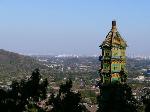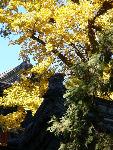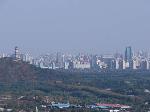- Getting around Lijiang. Dont stay in the Old Towns more than 2 days, there is nothing to do. KRISS Oct 9, 2013 05:46
- 2013 Beijing Temple Fair BENNYLAU Feb 26, 2013 03:29
- Malaysian traveling from KUL - LAX vis Shanghai PVG ZATI_DY Jan 3, 2013 20:15
Into the Fragrant Hills
- Views: 3874
- |Vote: 1 0
- |Add to Favorites
- |Recommend to Friends
Autumn Reds
Come the Autumn months, and everyone in Beijing starts looking a little more cheerful. The weather cools down, the wind blows cooly through the old streets, and all eyes begin to turn to the west – as plans are made by one and all to get out of the big city for the day and head for the hills – Beijing’s enticingly named Fragrant Hills, to be precise.
They’ll tell you it’s for the fresh air, or for a spot of much-needed exercise, but most people visit the Fragrant Hills for just one thing – the colour red. Towards the end of Autumn, the Fragrant Hills’ carpet of green blushes a bright and attractive crimson, and the mountainside becomes coated in a rolling ocean of broad red leaves. It’s the highlight of the year for many Beijingers, and as November approaches everyone’s talking about whether the trees have changed their shade yet, and which Saturday’s the best day to head out there. I wanted to see them too, and so got together with a small group of friends to visit the mountains and see them for myself.
There are several good routes to get across the 10Km distance to the mountains – we took a direct bus from outside the Beijing Zoo near the convenient Xizhimen subway transfer station. Tourist busses get out there too, and a metered taxi fare should be well within the price range of most classes of tourist in the city. Travellers who don’t like the old bumpy busses should consider that the trip takes more than an hour, and if you’re going at the right time, the bus will be packed with like-minded folks. I didn’t mind the ride, and enjoyed watching as the skyscraper corridors of central Beijing thinned out into the suburban sprawl.
However, if you do want to see the hills sans crowds, there are plenty of reasons to go in other seasons, botanical and otherwise. The groves of peach, cherry and pear trees blossom unashamedly in the Spring, making a lovely display – and if you like the blossoms, the majestic Botanical Gardens aren’t far away with even more delicate performances of the raining petals. Summers are cool on the mounts thanks to the elevation – good news for locals who get tired of sweating out the long hot months – and in Winter, the whole area is transformed into a fairyland after a fresh snowfall.
The thousands of yearly visitors to the park are not amongst the first to appreciate the lovely scenery in such good proximity to the capital. Enthusiastic visitors have been visiting the Fragrant Hills for hundreds of years, and successive dynasties set increasingly beautiful installations – temples and pagodas and the like – about the mountainside. The Emperor Qianlong was one of the most dedicated to developing the park, and had numerous wonders constructed there – but in a bitter twist of history not unfamiliar to historians of Chinese, all of these – even the blueprints – were thoroughly destroyed by invading European forces in the early 1900’s.
Into the Fragrant Hills
As the bus drew closer to the park area, the streets began to take on a far more rural character with greater numbers of trees, older homes, and peaceful, quiet settings. Presumably, the farming families who live out here are the descendants of those who used to watch the imperial processions march by; now they observed the streets of happy commoners from the city and busloads of tourists pass excitedly – accordingly, many have set up shop and the streets on the approach to the park entrance have become bustling lanes of stores, restaurants and roadside merchants, all catering for hungry park visitors. This in no way detracts from the charm of the Fragrant Hills – indeed, it adds to it. Although I was arriving at the park at the most crowded time, wandering up the busy streets to the smells of roasting nuts and sizzling pancakes brought on a festival atmosphere to my visit.
When my friends and had gone in through the north entrance the park at last, there seemed to be several different directions we could take, with a number of temples and structures at the foot of the mountain to explore as well as taking the climb to the top. Despite the destruction of artifacts by the Eight Countries Alliance at the beginning of the last century, much restoration work has been completed and there are many sites throughout the park that are worth visiting. The atmosphere was fresh, the view up the mountain was delightful – although we hadn’t as yet spotted the fabled red leaves – and we felt at leisure to wander freely. Most guidebooks I’ve read on the subject recommend first climbing the mountain and then descending towards the most spectacular temple – the Azure Clouds Temple – to complete the day’s excursion. We decided to visit the temple first and tackle the mountain slopes a little later on.
The walkway to the temple leads through picturesque grounds that are particularly photogenic. Old walls scarleted in traditional bright paints, arched eaves and hanging old bells, stone lions and groves of bamboo, all work together into an Oriental fantasy garden that is breathtaking in the Fall. Under one tree lay a white statue of a warrior that seemed to rest in a shallow grave – the sign revealed that in fact the statue had only been discovered a few weeks before – leading one to wonder just how many of Beijing’s artifacts still lie beneath the soil.
The white temple itself is magnificent, crowned by a stunning Indian-style Dagoba that is surrounded by a series of strange towering stupas. We’d already ascended to a fair height in our approach to the temple, and when we finally stood at the top, we were rewarded by an exemplary view from a distance of Beijing. Beijing is a gigantic city by anyone’s standards, but from this distance it’s obvious that the city is not only large but also extremely flat. A massive rectangle on the plains, the city smoothly covers the landscape in giant blocks and towers, and from a distance, only the TV Broadcasting spire with its revolving restaurant above presides over the city in a way that it doesn’t appear to from within.
The remaining structures within the temple are fascinating enough to spend the day browsing in themselves. One odd feature is a mausoleum that once held the body of Sun Yat-sen – leader of the original Chinese revolution and the first liberator of modern China. His body apparently wasn’t here for very long before it was taken to Nanjing where it probably now lies (there are rumours that it was stolen and removed to Taiwan in 1949). Far more enchanting is the labyrinthine Hall of Buddhist Saints, a darkened warren lined on every wall with statues of the Arhats – glittering grotesquely in the half-light. They grimace and smile peacefully, they twists and recline – each statue is different and the effect is both eerie and mysterious.
I’d have stayed longer, but it was already getting on into the afternoon – and we hadn’t begun our ascent proper of the Xiangshan mountain itself, and so we carefully made our way back down to the front entrance and began to follow the path upwards.
Incense Burner Peak
Incense Burner Peak is the tallest mountain in the whole park, and it is so named because of two gigantic stones at the top which are shaped like incense burners. There are cable cars that take lazier travellers to the summit, from where an even more rewarding view of Beijing can be seen, but for those more determined to meet challenges, the climb to the top is not easy but achievable, and with this is mind my friends and I began our ascent.
Passing a wide lake bisected by a pretty bridge, we chose from a number of diverging pathways to the top and soon were rapidly gaining height. Within ten minutes we were already at the foot of one of the park’s iconic attractions – a green octagonal pagoda that stands erect above the forest all glossy and shiny in the sunlight. We couldn’t see a way into the tower, and so continued on.
One of my friends, who is particularly muscular, took to the path with great energy that even surprised the locals – a pair of Chinese girls watched him rapidly ascend the precarious path and shook their heads admiringly – “Chi niu rou de zhen bu yi yang!”, one of them exclaimed – beef-eaters aren’t the same, referring to the fact that foreigners are said to eat a lot of beef. Little did they know my friend is a vegetarian!
There were other mutterings that we overheard as we ascended – most of our fellow travellers were complaining about the distinct lack of red leaves. Although there were plenty of red leaves on sale in embossed souvenir cards, the trees themselves were resiliently green. It led one to suspect that the leaves were plucked for sale as soon as they grew, but in fact we’d miscalculated and arrived too early for the display of crimson foliage – we’d have to be sure to return next year.
Finally, we stood at the top, looking down over Beijing. The peak is an interesting climb, but I began to understand why it’s recommended that it be visited before the temple – if you’ve already seen the vista of distant Beijing from there, the relatively similar view from the summit seems like an anti-climax. The roof of the Fragrant Hills is lovely enough, but spoilt if you’ve already had the preview at the temple. Regardless, we’d made it to the top, and were pleased to look out over the capital of China from one of its prettiest distant corners.






 Copyright © 1998-2025 All rights reserved.
Copyright © 1998-2025 All rights reserved.